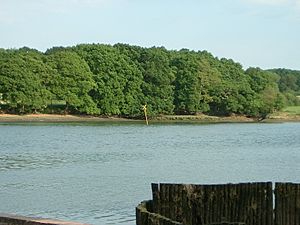Grace Dieu (ship) facts for kids
style="width: 315px; border-spacing: 2px; margin-bottom: 10px;"

The yellow hazard marker is sited on the wreck of Grace Dieu in the River Hamble
|
|
Quick facts for kids History |
|
|---|---|
| Name: |
Grace Dieu |
| Ordered: |
1416 |
| Builder: |
William Soper |
| Launched: |
1418 |
| Commissioned: |
1420 |
| In service: |
1420-1439 |
| Fate: |
Struck by lightning and burnt in 1439 |
| General characteristics | |
| Tons burthen: |
1,400 - 2,750 tons |
| Length: |
218 ft (66 m) |
| Beam: |
50 ft (15 m) |
| Complement: |
250 |
| Armament: |
|
The Grace Dieu was a huge ship built for King Henry V of England. It was his main ship, also called his flagship. Launched in 1418, it was one of the biggest ships of its time! However, it only sailed on one trip. Later, it stayed anchored in the River Hamble. In 1439, lightning struck the ship, and it burned down.
Contents
Building the Grace Dieu
The Grace Dieu was designed by William Soper. He was a important person in Southampton and worked for the King's Ships. This ship was built using a special method called "clinker-built." This means three planks were nailed together along the hull. Tar and moss were placed between the wood to make it waterproof.
The ship was about 218 feet (66 meters) long. Its width, called the beam, was 50 feet (15 meters). To give you an idea, it was similar in size to the famous HMS Victory. It was also twice as big as the Mary Rose! The Grace Dieu was very heavy, weighing between 1,400 and 2,750 tons.
How it was built
Building such a large ship needed a lot of wood. Workers used 2,735 oak trees, 1,145 beech trees, and 14 ash trees for its timbers. A special dock was even built in Southampton just for its construction.
Some parts of the ship, like planks and ribs, looked a bit rough. This suggests it might have been built very quickly. When it was finished in 1418, it was truly one of the largest wooden ships ever built.
The 1420 Voyage
In 1420, the Grace Dieu went on its only journey. The Earl of Devon was in charge. The plan was to sail down the English Channel. But trouble started even before the ship left the port!
Crew Problems
The crew did not want soldiers and archers on board. They felt these guards were not needed. The sailors tried to stop a clerk from writing down the soldiers' names. They even threatened to throw his list into the sea!
When the ship finally sailed, nine crew members caused more problems. They refused to do their jobs and demanded the trip be stopped. So, the Grace Dieu had to go to the nearest port, St. Helen's on the Isle of Wight. The crew then left the ship. A clerk who questioned their loyalty had his clothes torn.
After King Henry V's Death
King Henry V of England died in 1422. His ships were seen as his own property, not part of the country's navy. Many of them were sold to help pay his debts.
In 1430, William Soper, who was in charge of the entire navy, had dinner on the Grace Dieu. He met with the leader of the Florentine merchant fleet there.
Later, the Grace Dieu was stored in the River Hamble. Its mast and other equipment were taken off. In 1439, lightning struck the ship. It caught fire and burned down to the waterline.
Finding the Wreck Again
The remains of the Grace Dieu are still in the River Hamble today. You can find them near Bursledon, close to Southampton, in Hampshire. For many years, people thought the wreck was an old Danish ship or a merchant ship from the 1800s.
In 1933, a proper study was done. It showed that the wreck was indeed the Grace Dieu and confirmed its huge size. The site is now protected by law. In 2004, a TV show called Time Team explored the wreck for their 2005 series. Only 50 meters away, there are remains of another ship. Many believe it is the Holigost, another ship from the same time as the Grace Dieu.

